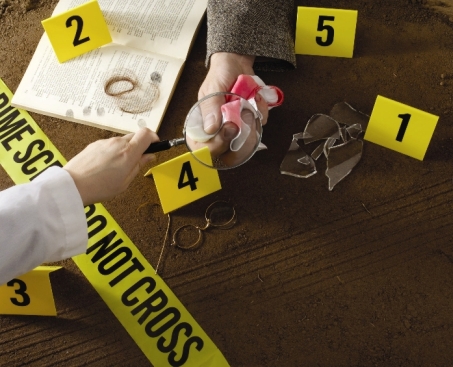You come home and something doesn’t seem quite right. The kitchen window is open. You have no recollection of having opened it. Your mind races as you assume the worst: someone has broken in. Sure enough, you discover that the dresser drawers in the master bedroom have been ransacked. Several valuables are missing.
You’ve already done a bit of forensic work. In your mind, that is. Crime reconstruction involves the fundamental reasoning processes of the human brain. What can be recreated and staged before the eyes isn’t as important as what can be staged behind them. Deductive reasoning – the process of going from a general statement to a specific conclusion – is the most important tool a criminologist can possess, and this tool works hand in hand with crime reconstruction.
The open windows, the ransacked drawers, the missing valuables – all are pieces of a larger puzzle that answer the first question: What happened?
The questions asked during crime reconstruction are analogous to the pyramidal questions journalists attempt to answer when writing a story, with an exception as to their order of importance. In crime reconstruction, the most important is what, followed next by where, how, when, who, and why. This order is by no means arbitrary. To understand why this is so, we need to examine the principles of crime reconstruction.
Principles of crime reconstruction
Dr. Edmond Locard, the French criminologist and pioneer of forensic science, lent his name to the basic tenet of criminology is known as the Locard Exchange Principle: Any person who commits a crime leaves some trace of his or herself behind, no matter how minute. Reconstructing the crime can point the investigator toward these potential areas of contact. However, though Locard’s principle may be sound in theory, reality is under no obligation to conform to it so neatly. The truth is that some forms evidence are just too difficult to perceive. This leads to an incomplete picture. As a result, the layperson may find herself engaging in supposition, while the criminologist knows better than to hold up supposition to legal scrutiny. Hence, some crimes – a relative few – are yet unsolvable.
Notice that in our hypothetical scenario, the physical evidence – the window, the ransacked drawers – can be analyzed to answer the first four questions. What happened, where did it happen, how did it happen, when did it happen. The who and the why are more difficult, and rely not only on answers to the previous questions, but also on inductive reasoning, which must be used as carefully as any delicate instrument. Inductive reasoning leads a series of statements from specific details to a general conclusion. A statement may proceed as follows: “John, Jack, and Jim are all wearing blue shirts. John, Jack, and Jim are men. Therefore, the next man we see today will be wearing a blue shirt”. Simply put, inductive reasoning often involves a qualifier after the conclusion that states, “Not necessarily”.
So why use inductive reasoning at all? The answer is because criminology deals with unknowns, gray areas, and all manner of uncertainty. One of these uncertainties deals with human behavior and motivation: the answer to the question why.
In our hypothetical, it may be easy to discern why the place was ransacked. The suspect was after valuables. But what if the situation was compounded? What if there was a body? What if nothing was found to be missing? The question of why is suddenly more mysterious. Speculation here relies on inductive reasoning.
So a crime must be reconstructed impressionistically, with different facets of evidence contributing to the portrait. The evidence may take the form of, but is not limited to:
- Physical evidence
- Victim statements
- Eyewitness accounts
- Statements from suspects
- Documentary evidence
- Common sense
The reconstruction then begins, with the aim of:
- Eliminating events for which there is no physical evidence of having occurred
- Determining events for which there is ample physical evidence for having occurred
The puzzle is then assembled. Investigators realize that the picture will always be incomplete. The goal is to complete it as best as she can, with the hope that gaps in knowledge are small enough not to perforate the picture out of focus entirely.
